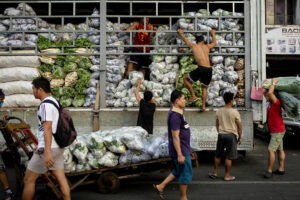RISING FOOD PRICES, a stronger-than-expected El Niño, sluggish local government spending and high interest rates are among the domestic threats to the Philippines’ growth target for next year, the Finance department said on Tuesday.
At a Palace briefing, Finance Secretary Benjamin E. Diokno said possible “elevated prices due to inadequate food supply” is a major domestic risk to the government’s 6.5%-8% gross domestic product (GDP) growth target for 2024.
He noted that a stronger-than-expected El Niño, which may last until June 2024, and the spread of highly infectious animal diseases could tighten food supply.
The “limited” absorptive capacity of local government units (LGU) and some government corporations is also a threat to the growth goal, he added.
Mr. Diokno also cited cooling pent-up demand and the impact of interest rate hikes as risks to the economic outlook.
The Bangko Sentral ng Pilipinas (BSP) has hiked borrowing costs by 450 basis points since May 2022 to tame inflation.
Headline inflation eased to a three-month low of 4.9% in October but exceeded the BSP’s 2-4% target for the 19th straight month. Year to date, inflation averaged 6.4%.
Mr. Diokno said the BSP expects inflation to ease to the 2-4% target range by the first quarter of 2024.
“It might increase again but it will end up at the midpoint between the 2-4% target range by 2024 and 2025,” he said. “That means inflation is going to be managed well. It will be within the target range for the next two years.”
Earlier this month, the BSP raised its baseline inflation forecast to 6% in 2023 (from 5.8% in September) and to 3.7% in 2024 (from 3.5%) but cut its 2025 inflation estimate to 3.2% (from 3.4%).
Despite the risks to the outlook, Mr. Diokno said the government is confident its 6.5%-8% growth target for 2024 to 2028 is achievable.
“What are we doing to do [to achieve] that? Number one, we should continue our anti-inflation drive because lower inflation means more purchasing power for consumers,” he said.
The Finance chief said the government will “rigorously implement government spending catch-up plans in the last quarter 2023 and avoid underspending in the first semester of 2024 through efficient budget execution.”
A recovery in government spending helped the economy grow by a faster-than-expected 5.9% in the third quarter.
For the first nine months, economic growth averaged 5.5%, still below the government’s 6-7% full-year target. The economy will need to grow by 7.2% in the fourth quarter to hit the low end of the government’s target.
Mr. Diokno pointed out the Philippines’ 5.5% GDP growth in the January-to-September period outpaced China’s 5.2%, and Indonesia’s 5.1%.
“If you can see, Asia is the fastest-growing region in the world; we are the fastest-growing economy in the fastest-growing region in the world,” he said.
Mr. Diokno said the economy also faces external risks such as geopolitical and trade tensions, a property crisis and the latest pneumonia outbreak in China, as well as a possible US recession.
EO 10 EXTENSION PUSHEDMeanwhile, the Finance department continues to lobby for the extension of the reduced most-favored nation tariff rates for rice, corn, and pork under Executive Order (EO) No. 10. The lower tariff rates are in force until Dec. 31.
To address supply issues, the government is also considering the use of remote sensing technology such as satellites for corn and rice production, Mr. Diokno said. “Through the use of technology, the government will fast track the response to address the impact of adverse weather conditions and the implementation of the El Niño mitigation and adaptation plan.”
He said the government will continue to provide subsidies to vulnerable sectors such as farmers and transport workers.
“What is important is targeted intervention, targeted subsidy for those who will be affected by the inflation,” he said. “So, these are usually the farmers, the fisherfolks and the transport sector.”
At the same briefing, Mr. Diokno said the Philippines hopes to benefit from the relocation of major production activities of foreign manufacturers and other businesses from China, which has been beset by economic challenges including a property crisis that has shaken investor confidence.
Companies that have moved their supply chains out of China have chosen Vietnam and Indonesia, he noted. “Maybe, we will be included in that grouping,” he said, referring to the so-called VIP group.
GLOBAL CORPORATE TAXMeanwhile, Mr. Diokno said it may be too early for the Philippines to adopt the 15% global minimum corporate tax being pushed by the Organisation for Economic Co-operation and Development (OECD).
“It’s too early to go to mid-15%. But that’s a good floor,” he said. “You will have to weigh whether you can really afford the 15% rate.”
Under the new rules pushed by the OECD, companies paying below 15% in a low-tax jurisdiction will face a top-up levy either in that jurisdiction or in their home country starting in 2024.
Albay Rep. Jose Ma. Clemente S. Salceda, House Ways and Means Committee chair, said proposed changes to the Corporate Recovery and Tax Incentives for Enterprises law should also consider the possible impact of the 15% global minimum corporate tax, which other countries have adopted.
Mr. Diokno said that in any event, an investor will go to a country not only because of the tax regime but also for the economic opportunities. — Kyle Aristophere T. Atienza
